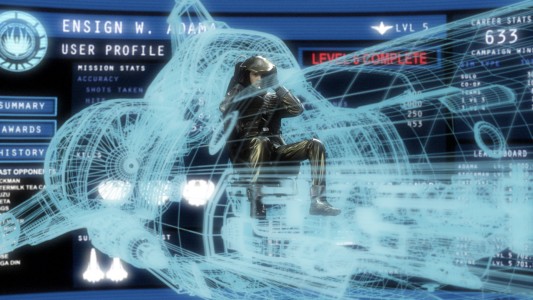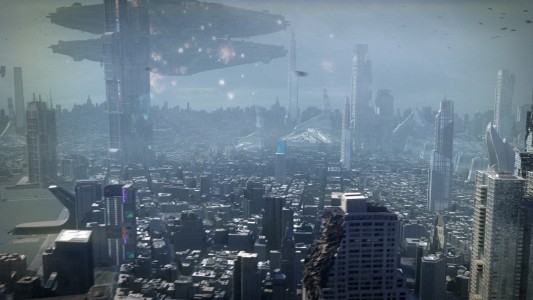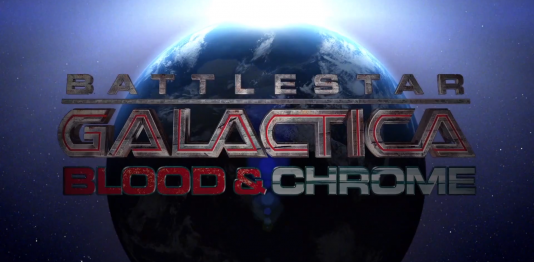The NBC Universal production team used LightWave 3D software to create almost all sets and background for the new sci-fi series.
A new version of the popular science fiction drama Battlestar Galactica has taken flight on the Internet, with a novel twist. The 10 episodes of Battlestar Galactica: Blood & Chrome were created almost exclusively without sets, instead using live actors in front of greenscreen. The production relies on computer-generated effects to supply sets and location as well as the typical CG characters and effects.

Blood & Chrome, from NBC Universal, was originally envisioned as an Xbox project comprising nine 10-minute segments on a budget of only $2 million. “Obviously, we can’t shoot Battlestar Galactica for $2 million,” says Gary Hutzel, visual effects (VFX) supervisor at Universal Cable Productions and on Battlestar Galactica: Blood & Chrome. “I suggested that we look at a radically different approach to the show: to shoot it entirely against greenscreen. As the project gained momentum and the studio realized the cost benefits of this approach, the project gained more financing and grew into a two-hour ‘backdoor’ pilot for a potential television series.”
The series premiered November 9 on the Machinima Prime YouTube channel. Ten episodes will be uploaded and available until February 2013 when Syfy, a cable channel owned by NBC Universal, is expected to televise the pilot and also offer it on DVD, Blue-Ray, On Demand, and digital download.
The production team is using NewTek’s LightWave 3D software, which was also used on the 2004-2009 remake of the 1970s classic as well as the 2010 prequel Caprica. The software has been a constant in the show’s production pipeline for everything from otherworldly atmospheres to earth-shattering visual effects. Blood & Chrome continues the tradition, adding Cylon robots, snake creatures, and more than 20 sets constructed entirely in LightWave 3D.

No sets, no locations
Hutzel and his team were faced with a formidable challenge: producing a Battlestar Galactica-quality, VFX-heavy film from scratch—with “no sets and no locations,” he recalls—at a cost far less than a typical sci-fi pilot. “The way that we accomplished that was to do the entire show on greenscreen,” Hutzel describes, “and I mean the entire show. We are breaking the mold. Right now, we have 89 minutes of content and roughly three minutes of that is filmed against a set piece. The rest of it is greenscreen or pure CGI (computer-generated imagery). That’s how we attacked the project.”
“We are not a visual effects house in the normal sense,” affirms Doug Drexler, CG supervisor on Blood & Chrome. “Gary has set up a new paradigm. In his model, visual effects is part of the production, just like the art department. We’re there to do anything needed to get the job done.”
Blood & Chrome pushes the new paradigm even further, Drexler adds. “The visual effects department art directed, built, lit, and lined up the shots, designed all the action sequences, created the mood, and drove home the intent of every single scene. What person who fancies himself a filmmaker doesn’t dream of being able to do that? And what other department could even conceive of being able to?”

Progressive pipelines
After the team shot the live action against greenscreen, the artists moved ahead with designing the virtual elements, including the mood and look, says Drexler. “The computer and LightWave give us a lot of freedom; we can experiment to our hearts’ content without the constraints of budget and building physical sets.”
Drexler and his team of 10 CG artists used LightWave to retrofit the Galactica, including the Battlestar’s interior sets. “Because the show was all greenscreen, we had an opportunity to expand the ship and give it greater scope.” He and the artists pushed back walls and raised ceilings, but stayed true to the original Galactica design and layout.
Extensive virtual environments permeate the entire pilot. Hutzel’s goal was to create environments that enhance the live action shots on greenscreen, without drawing so much attention that the audience is aware of them. “We have a very natural feel with some large-scale elements that are very believable,” he affirms. “LightWave was instrumental because we can work with very large, high-resolution models very quickly. The latest visualization and lighting tools really expedite that process. I can literally light on the fly, just like I would if I were lighting a set. You simply can’t do that reliably in other packages and get the kind of results that we have.”
“LightWave has increased in flexibility and quality to the point where we feel very comfortable going into a project like Blood & Chrome and saying to the director and writers: ‘Write whatever you want. It doesn’t matter. You’ve paid to have us to do every shot on your show, write anything,’” exclaims Hutzel. “That is exactly what we did on Blood & Chrome, and we’ve been successful in bringing this idea to life. VFX are no longer cost-prohibitive.”
The bulk of the VFX shots for Blood & Chrome were created using LightWave 3D software with a majority of the artists having 10 or more years’ experience working with LightWave.






